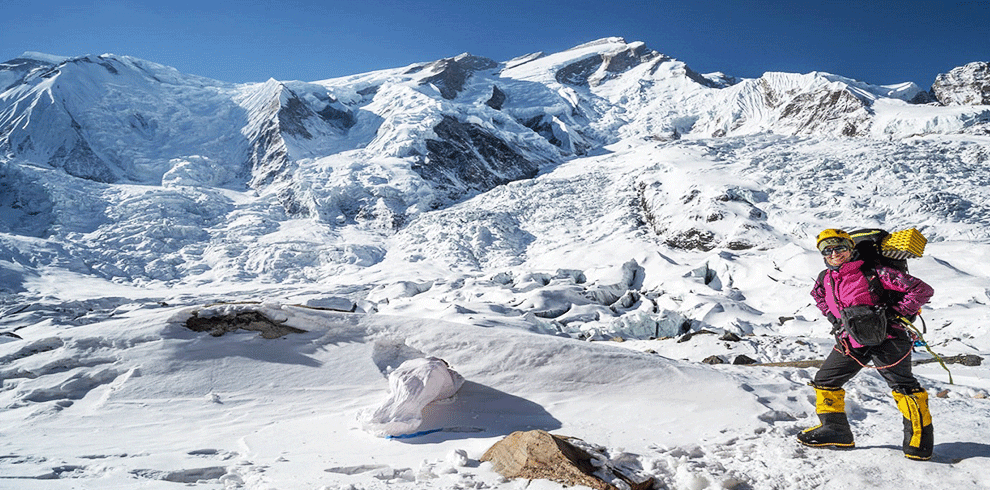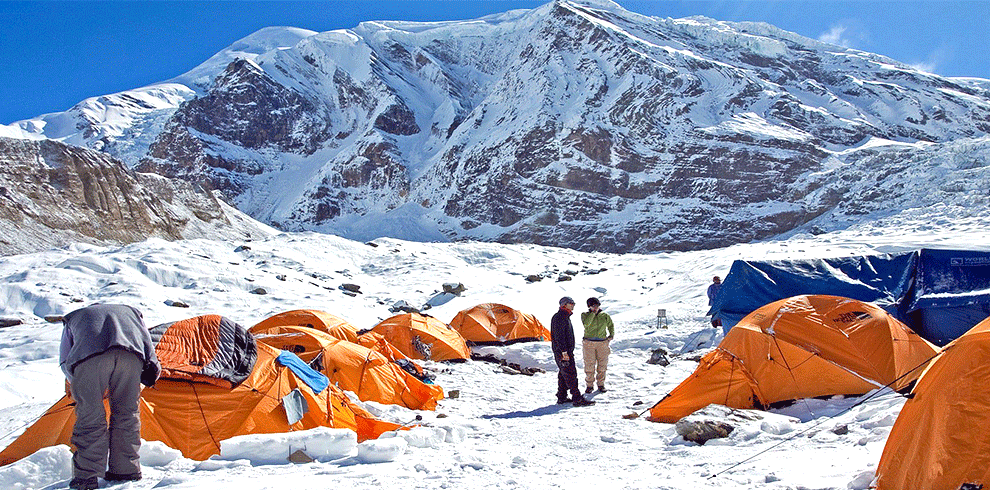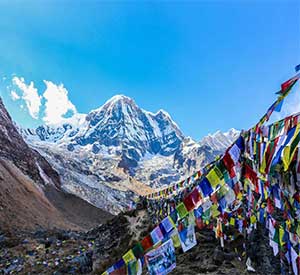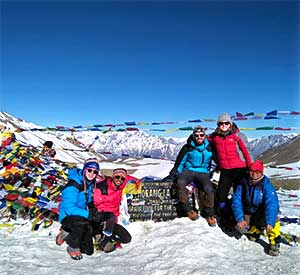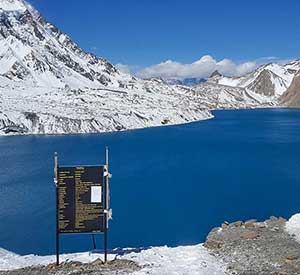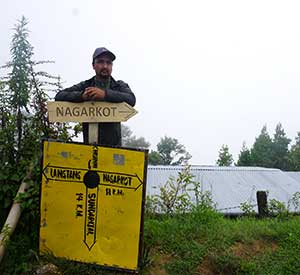Dhaulagiri Expedition Introduction:
Dhaulagiri (8,167 meters) also known as White Mountain is the seventh highest mountain in the world among the most popular 8000 meters peaks for Himalayan expeditions. It forms the eastern anchor of the Dhaulagiri Himal, a subrange of the Himalaya in the Dhaulagiri Zone of north central Nepal.

It lies northwest of Pokhara, an important regional town and tourist center. Across the deep gorge of the Kali Gandaki to the east lies the Annapurna Himal, home to Annapurna I, one of the other eight-thousanders.
When Dhaulagiri was first discovered in 1808, it was thought to be the highest mountain in the world for westerners. It remained the highest peak for 30 years before Kanchanjunga took its place. Dhaulagiri justifies a magnificent peak rising as a giant shoulder of shining ice and snow.
The South and West faces of Dhaulagiri both feature massive drops; each rises over 4000 meters from its base, and each has been the site of the historical climbs. The peak was first conquered in 1960 by a via North East Ridge which has been the normal route of ascent for most of the climbing to date.
Kurt Diemberger, Peter Diener, Ernst Forrer, Albin Schelbert, Nyima Dorji and Nawang Dorji, members of a Swiss/Austrian expedition, firstly conquered the Dhaulagiri expedition on May 13, 1960 via North East Ridge, which has been the normal route of expedition for most of the climbing to date.
Northeast Ridge route which had been reconnoitered one year earlier by an Austrian expedition led by Fritz Moravec. This was also the first Himalayan climb supported by a fixed-wing aircraft. The aircraft, a Pilatus PC-6, crashed during an approach and was later abandoned in Hidden Valley north of the mountain.

Dhaulagiri is buttressed by five ridges which offer the possibilities of different routes of ascent through six different routes have been established for climbing so far. The vast majority of the ascents to date have been via the first ascent route, which is the Normal Route on the mountain. However, ascents have been made from almost every direction for the Dhaulagiri Expedition.
Dhaulagiri Expedition to this 8167 m Himalayan massif is the seventh highest mountain in the world. It is located in the north central part of Nepal. The crest of the mountain stretches some thirty miles giving structure to an otherwise tangled topography of twisting ridges, glaciers and icefall.
Are you looking for other trips than Dhaulagiri Expedition?
Nepalgram Adventure can help you with the filter below. Select the right destination and activity of your interest to find the best trip to Nepal.
Along the main crest, several pyramid-shaped peaks rise. All four of these peaks each rise 7000m over the Kali Gandaki gorge to the southeast within about 30km. The Kali Gandaki gorge lies between the Dhaulagiri and Annapurna. This creates a face-off of two eight-thousander giants over the deep Kali Gandaki valley.
First climb
First on May 13, 1960 by a Swiss/Austrian/Nepali expedition. Most ascents have followed the northeast ridge route of the first ascent, but climbs have been made from most directions. As of 2007 there had been 358 successful ascents and 58 fatalities.

When the French got permission to climb either the Annapurna or Dhaulagiri, they chose Annapurna after making a reconnaissance of Dhaulagiri in 1950. In 1953, a Swiss party failed, then an Argentine group tried, but failed one year later. And finally, the Swiss expedition reached the summit in 1960, following a circuitous route around the mountain from Tukuche, over the Dhampus pass.
The French failed to climb the summit from the North-East Col so their expedition was supported by a Swiss Pilatus Porter aircraft, the “Yeti” which landed on the North-East Col at 5977m. But the plane crashed just before the end of the expedition near Dhampus pass. The pilots, including the famous Emil Wick, walked down the mountain to Tukuche.
Dhaulagiri Expedition outline Itinerary
- Day 1 – Arrival at Kathmandu International Airport
- Day 2 – Trip preparation and city tour of Kathmandu or Patan and Bhaktapur.
- Day 3 – Final preparation day in Kathmandu for expedition
- Day 4 – Drive from Kathmandu to Beni takes about nine hours.
- Day 5: Drive from Beni to Darbang (1110 m.) which takes about 5 hours.
- Day 6 – Trek from Darbang to Muri via Takum takes about 5 hours.
- Day 7 – Trek from Muri to Naura (1570 m.) takes about 5 hours.
- Day 8 – Trek from Naura to Bagar (2080m.).
- Day 9 – Trek from Bagar to Dobhang (2520 m.).
- Day 10 – Trek from Dovan to Chaur Bag Khola (3445 m.) takes about 5 hours.
- Day 11 – Trek from Chau Bag Khola to Italian Base Camp (3660 m.) takes about 4 hours.
- Day 12 – Trek from Italian Base Camp to Japanese Camp (3890 m.) and it takes about 5 hours.
- Day 13 – Trek from Japanese Camp to Dhaulagiri Base Camp (4748 m.) which takes about 5 hours.
- Day 14-43: Climbing period (Base Camp – Summit 8167 m – Base Camp) of Dhaulagiri Mountain
- Day 44: Trek from Dhaulagiri Base Camp to Hidden valley via French pass (5010m.) takes about 5 hours.
- Day 45: Trek from Hidden Valley (5200m) to Yak Kharka takes about seven hours
- Day 46: Trek from Yak Kharka to Marpha (2670m.) takes about five hours.
- Day 47: Drive from Marpha to Pokhara by Jeep/Bus. Stay overnight at hotel in Pokhara.
- Day 48: After breakfast early morning, drive from Pokhara to Kathmandu that takes about seven hours.
- Day 49: Free day in Kathmandu for shopping and recreation
- Day 50: Departure
Download Detail itinerary of Dhaulagiri Expedition![]()
More destination from Nepal
Explore Nepal with us – to the deep in those nook and corners of Nepal Himalaya. Suggestions other than Dhaulagiri Expedition.
Annapurna Conservation Area (46 Trips)
Nar Phu Valley (3 Trips)
Annapurna Base Camp (5 Trips)
Thorong La pass (8 Trips)
Tilicho Lake (2 Trips)
Shivapuri National Park (6 Trips)
Itinerary
You will be greeted with flower garlands/Khadas. Our representative will then take you to your hotel. If time prevails, you will visit office for paperwork. Stay overnight at the hotel in Kathmandu.
Today, you will visit popular world heritage monuments in Kathmandu including Kathmandu Durbar Square, Boudhanath, Swoyambhunath, and Pashupatinath. Alternatively, you can choose Bhakatapur and Patan sightseeing. By late afternoon you will drive back to your hotel. Stay overnight at a hotel in Kathmandu.
You follow the Marshyangdi gently up through heavily terraced fields and small hill towns to the Seti River that takes you directly into Pokhara. Pokhara is tourist's paradise with lakes, caves, temples of Buddhist and Hindus along with beautiful mountains. It then descends to Nayapul with views of Annapurna South, Fish tail, green hills, terraces and villages. To reach Beni, your drive moves along the bank of the Mardi River. This is one of the most picturesque road journeys. You can also fly to Pokhara from Kathmandu and drive to Beni. Stay overnight at lodge.
Same day, you will trek from Darbang to Takum takes about 4 hours. This day your trek ascends through a narrow path for early one hour. Next, you go along the flat land passing through jungle with varieties of rhododendrons, oaks and Christmas trees at some distance. After you cross a small stream, your trail follows an ascending path until you reach Takum. Here, you camp behind the school located in central Takum. Here you will also find a Hindu temple where the villagers go to submit their offerings. Stay overnight at camp.
You start trekking on a descending trail for an early one hour passing through jungle. Then you follow an ascending path and before you approach Muri you pass along flat land until you reach Muri. This is a small village mainly inhabited by Gurung and Rai, one of the ethnic communities of Nepal. Stay overnight at camp.
Soon you descend through a forested area, emerging to a ridge snout where Bagar (2080) is visible. Descend through terraced fields to this mountain village where you camp in people's yards or the terraced fields. Stay overnight at camp.
Here, you leave the villages behind and the trial becomes increasingly challenging. Stay overnight at camp.
It is also known as Sallaghari. Stay overnight at camp.
Passing through the beautiful forest you rapidly gain altitude and mountains burst out all around. You camp for the night.
After crossing the first glacier, probably using a rope in a couple of tricky spots, you climb onto the main glacier. The surroundings are spectacular which makes up for the rough and dangerous trail. We may also use a rope on this section. This is a particularly tough day. You camp on the glacier rubble. Stay overnight at camp.
Soon the rough rubble gives way to the smooth ice of the white part of the glacier. You climb steadily to the rough and chilling but spectacular Dhaulagiri Base Camp. Stay overnight at camp.
Three high camps will be made before you go for final summit of world’s 7th highest peak. Stay all nights in camp.
You trek along trail covered with ice and soft snow. The stunning views of the Dhaulagiri range completely enchant you. Stay overnight at camp.
You traverse avalanche-prone slopes and then take on the steep descent to Yak Kharka. This day you trek through bare land for some distance. Stay overnight in camp.
This day the trail moves downhill until Marpha. On the way you pass small forests of juniper and other local vegetation. You will be accompanied by the splendid views of Nilgiri, Annapurna and rocky hills. Stay overnight at camp/lodge.
En route, you will enjoy the mountain views, green sceneries, rice terrace fields, vegetable fields and people being engaged in their daily life activities. If you choose to fly back to Kathmandu, it takes about 25 minutes. There are several flights from Kathmandu to Pokhara from morning to afternoon. Stay overnight at hotel in Kathmandu.
As per your flight schedule, our airport representative will transfer from your hotel to the airport for your final departure.


